Bathroom Workbook: 10 Elements of Industrial Style
http://decor-ideas.org 07/15/2014 23:14 Decor Ideas
You probably wouldn’t guess it, but turn-of-the-century rural farmhouses have a lot in common design-wise with big-city industrial buildings from the same era. Both types of structures were born out of a need for function at a minimum cost, and both have simple forms and were made from raw materials, with little attention paid to aesthetics.
This attention to simplicity, durability and function is why industrial style remains popular in bathrooms today. Since we’ve already looked at farmhouse style, here’s how you can incite an industrial revolution in your bathroom.
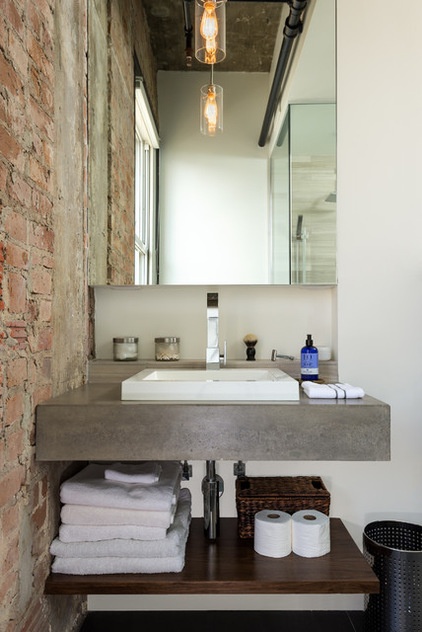
Raw materials in general. Simply put, industrial style takes cues from buildings of industry. Think more along the lines of old manufacturing — factories, warehouses etc. — rather than corporate offices. These buildings weren’t built with aesthetics in mind, but rather efficiency and budget. Basic materials like concrete, brick, steel and wood form the bulk of them, and they weren’t done to perfection.
“Masonry materials, sloppy mortar work, and quick and dirty bricks that are all uneven — it wasn’t deliberate. They were just going fast and being cheap,” says Jesse Hager, an architect at Content Architecture who designed the bathroom shown here, which is in a Houston building built in 1917 and converted to lofts in 1997.
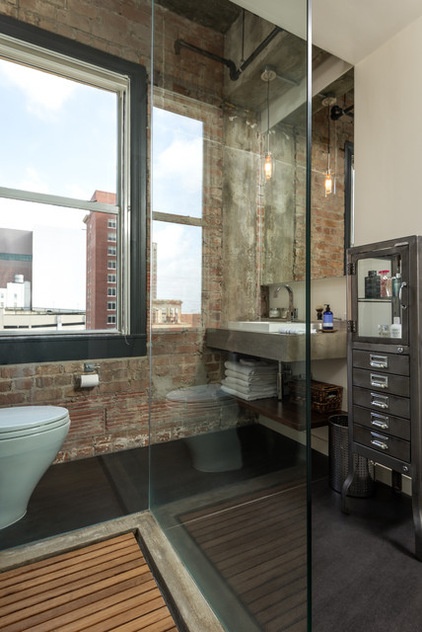
Of course, the setting and surrounding architecture play a big role. “It helps if the space already has old elements to play off of, like an exposed concrete frame or a brick wall,” says Hager. A concrete sink, a metal storage unit and exposed pipework are elements that, as we will see, adhere to the formula for industrial style.
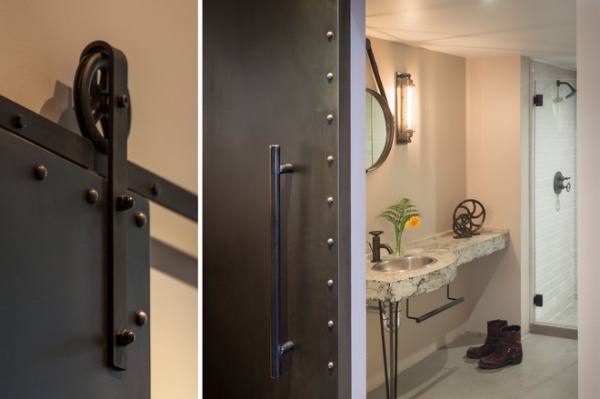
Steel. It’s hard to have an industrial bathroom without some presence of steel. “Steel as a raw material balances and grounds these kinds of spaces,” says Cindy Bayon, design manager at Muratore Construction + Design. “You expect it to be there in that setting.”
Bayon incorporated a mild steel-covered door with rivets in the San Francisco loft bathroom shown here. Leftover steel pipes form the towel bar, toilet paper holder and counter support, while a leather strap holds a steel-framed mirror.
Concrete. Nothing says industrial quite like concrete. A poured and cast concrete counter is a great way to establish the style in an existing bathroom that lacks other raw finishes like exposed brick walls. Bayon used concrete floors and a pitted concrete counter to continue the industrial edge in this bathroom.
Dark finishes. Shine is relatively absent in industrial spaces, unless it’s a blurred glimmer from stainless steel. Bayon recommends oil-rubbed bronze in industrial spaces. She used it for the sink and shower faucets here, which were chosen because they look like old industrial wheel turns.
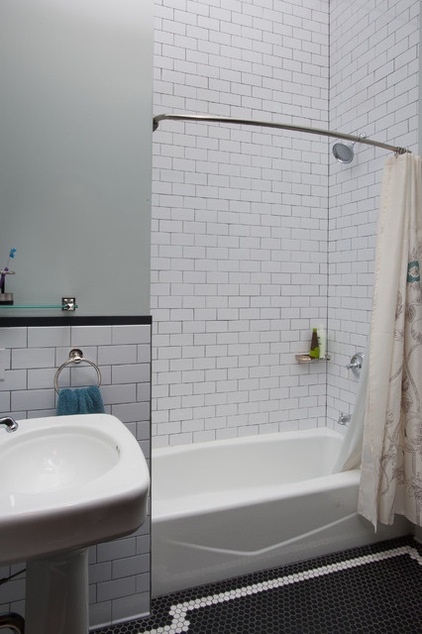
Subway tile. Though subway tile is slowly rising in cost due to its popularity, once upon a time, it was the cheapest option out there, so industrial builders used it extensively in warehouses and factories. There’s just something timeless and durable about it that makes it work in a variety of spaces, but it’s almost a prerequisite in industrial spaces. Darker grout, as shown here, will give it more of an aged feel.
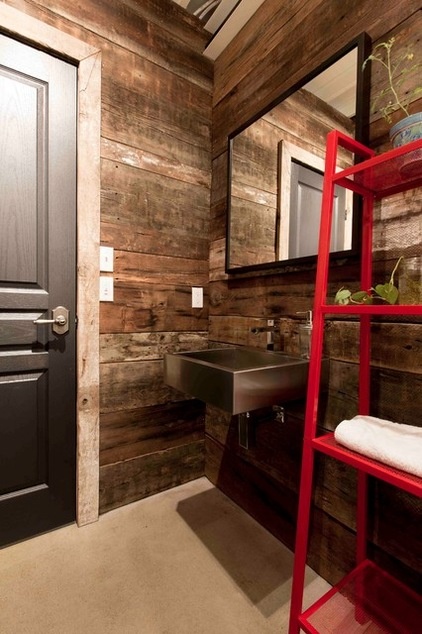
Wood. Hager notes that heavy timber beams are found in many industrial buildings in the Northeast, and that including raw wood is perfectly OK in modern industrial spaces; it’s even welcomed. In Claudie Dubreuil’s powder room (seen here) inside her shipping container house, recycled barn wood softens things up.
Stainless steel sinks. Though certainly not a requirement, stainless steel sinks are a great way to quickly strike an industrial tone. Dubreuil spent a lot of time finding one that she could bolt to the wall for more of a warehouse/factory look.
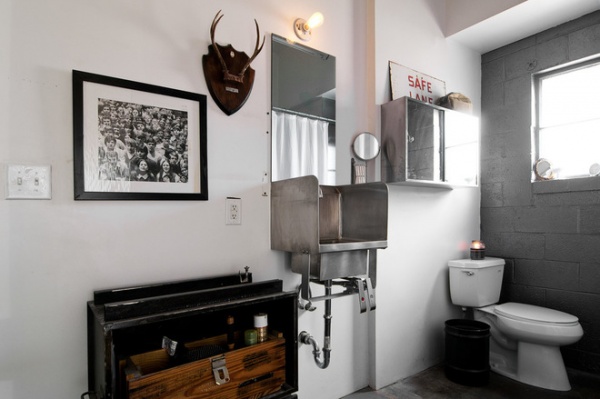
This stainless steel sink was likely left over from the building’s former life as an auto garage. Its imposing size and handles make it the center of attention.
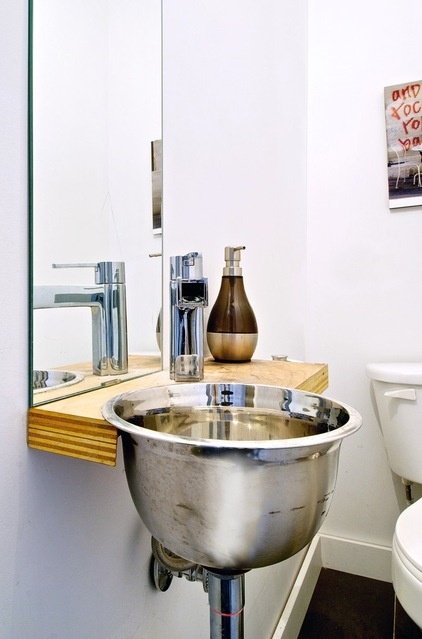
This stainless steel sink was actually built from a salad bowl. But look how it dominates the space and establishes an industrial presence.
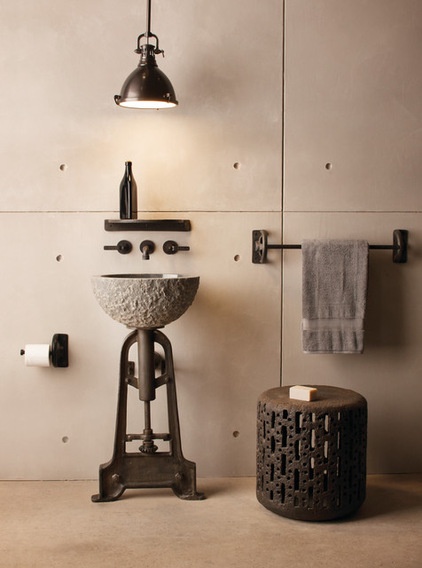
Minimal accessories. “Less is more in industrial spaces,” Bayon says. “You don’t want to call attention away from the materials. Personally, industrial is a minimalist style that’s all about the space itself. If you do bring in something like a toothbrush holder on the counter, keep it in steel or gray to not create an eyesore.” If knickknacks are introduced, stick to materials and shapes that recall machine parts, such as gears or cranks.
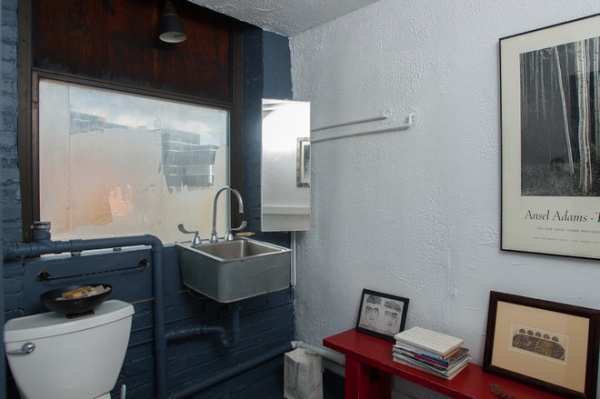
Exposed plumbing. This is probably difficult to change in a space that has concealed plumbing, but it’s a hallmark of the style. “Industrial spaces are about machines and moving parts and seeing how things work — gears and movement,” Dubreuil says. “They didn’t cover the plumbing or electrical, because there was no point. They were about profit and budget. They just needed a warehouse to make things, not look pretty.”
Avoid pastels. Bayon says some industrial spaces need some color to ground them from being too stark. She recommends sticking with more saturated colors, like dark blues, that will complement the grays of steel and concrete. “You could do a rusty orange, but whatever it is, it shouldn’t be primary colors or something so bold that it overpowers the space,” she says.
See more bathroom styles and remodeling guides
Related Articles Recommended












